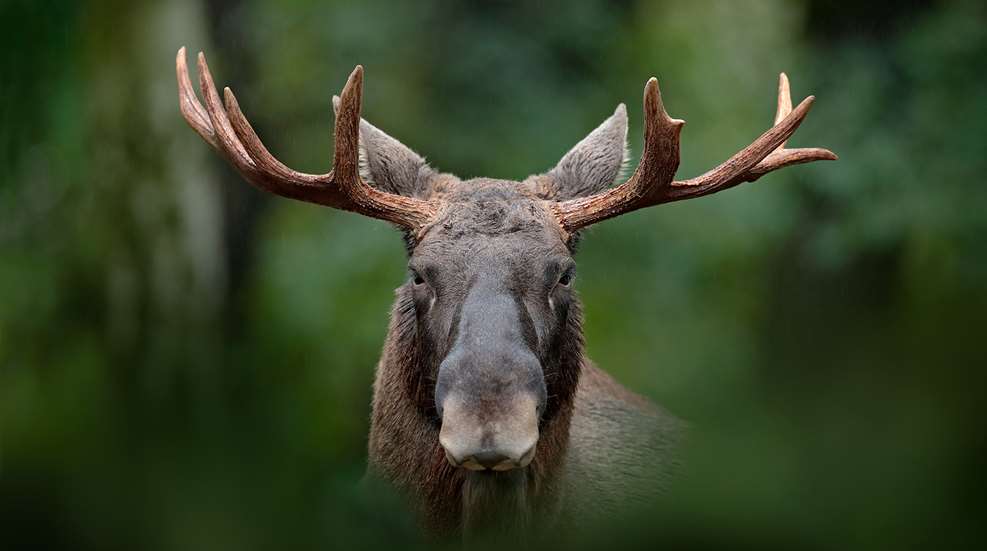
I did not grow up hunting. No, among Jewish people in New York City, hunting ranks rather low on the list of pastimes. Which is why when, in 1990, my father announced that he had been invited on a moose hunt in Finland, the rest of the family’s reaction was one of enormous amusement and a fair bit of worry. None of us—him included—knew anything about hunting or moose, though we knew a little about Finland since he had been doing a fair amount of business in that Nordic country over the previous decade. Which is to say, we knew it was cold.
My dad was invited on this traditional Finnish moose hunt by a large Finnish bank, and only sparse details were given before his arrival in Helsinki. The bit about it being cold and the bit about us being Jewish led my mother to buy him clothes warm and bulky enough to ensure he would survive a sudden onset of glaciation, which might have been a bit of overkill. While Southern Finland is indeed cold, in October it’s not all that much colder than, say, the Northeastern United States in late November. No matter; he could not be allowed to be chilly whilst pursuing what Europeans call an elk, but is really a moose.
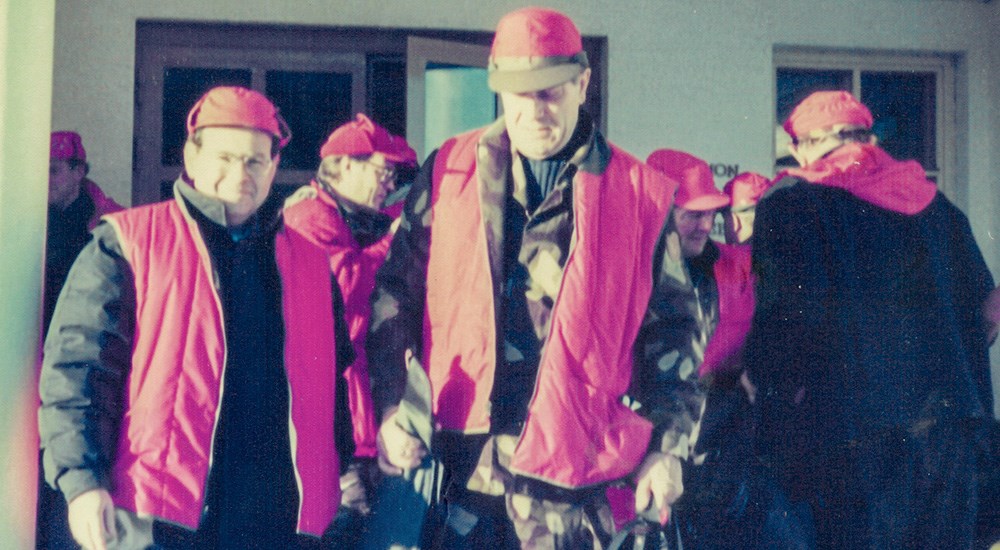
For someone who had never fired a gun before, the provided Sako rifle might have been intimidating, but Dad took it in stride and passed the test required to obtain a moose license. At a Finnish Defense Forces base, he and the other hunters had to deliver four hits from an offhand or kneeling position on a moving (paper) moose target at a range of about 75 yards. That’s actually a lot harder than it sounds, but since they told him where to aim and, as he noted, he had a magnified scope on the rifle, he passed with flying colors. More on that later.
The hunt itself was a traditional driven hunt, where Norwegian elkhounds (really a moosehound, but again, one Finn’s elk is an American’s moose) and their handlers push the game toward hunters sitting in raised stands. Each hunter wears a blaze-orange hat and vest and has a strictly defined field of fire to ensure safety. Shooting a moose outside that field of fire is very much forbidden, which is why, in the end, my dad did not take a shot on any animal. He did, however, get to be part of a hunting party that included the then-prime minister of Finland, Harri Holkeri.
So, my dad went on one hunt in a foreign country and the head of government of that relative backwater was there, too. So what? Well, for one thing, that told a 10-or-so-year-old me that hunting was not some weird blood ritual scary people west of the Hudson River practiced with mean old guns, but rather something pretty cool. It also made an offer last year to attend a Sako product showcase in Finland—and hunt moose with them—absolutely irresistible to me. Indeed, I skillfully fought off other, more qualified NRA Publications editors for the opportunity, which is why the editor of NRA’s personal-defense and tactical magazine is writing an article about hunting.
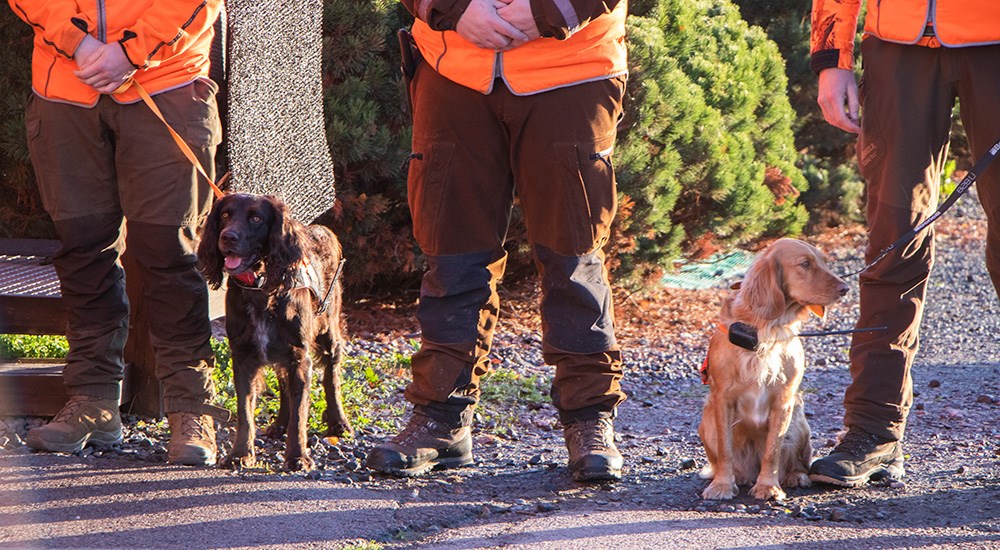
Sako is owned by Beretta, so the American end of things was handled by Beretta USA, namely by Joe Cunniffe, who is the company’s marketing manager for hunting products. In the course of our emails, I mentioned my dad’s hunt three decades prior and suggested it might be a fun idea if Sako invited the then-prime minister of Finland, the rather fetching Sanna Marin, on the hunt, since that would make for a wonderful closed-circle of a tale for this magazine.
 Photo: Laura Kotila / Finnish Government
Photo: Laura Kotila / Finnish Government
Alas, Ms. Marin’s interests are not, shall we say, as traditional as the late Mr. Holkeri’s, as you may have seen. But no matter; my excitement to attend what, for all intents and purposes, would be the same hunt that my father went on was palpable. When I think about it, my dad’s hunt played an enormous role in my choosing a professional career in the shooting and hunting industry.
Of course, the major difference, apart from Ms. Marin’s inexplicable absence, would be the host. I had the good fortune to be a guest of Sako rather than a bank. For hunting purposes, this makes far more sense, as Sako makes the darn rifles. That’s a bit of an understatement, since Sako rifles are among the best in the world, whether you’re talking about accuracy, reliability, overall quality and/or aesthetics. In fact, it was with a borrowed Sako 75 chambered in 7mm STW that I took my first animal, a mule deer at 260 yards in Utah in 2003 (again, Jewish kids from New York seldom grow up hunting, so my first hunt was a bit different than most). The Sako S20 is no exception. I was equipped with the Precision model, which sports a target-style stock with a near vertical grip, a very quick spring-adjustable comb and M-Lok attachment points at the front of the fore-end.
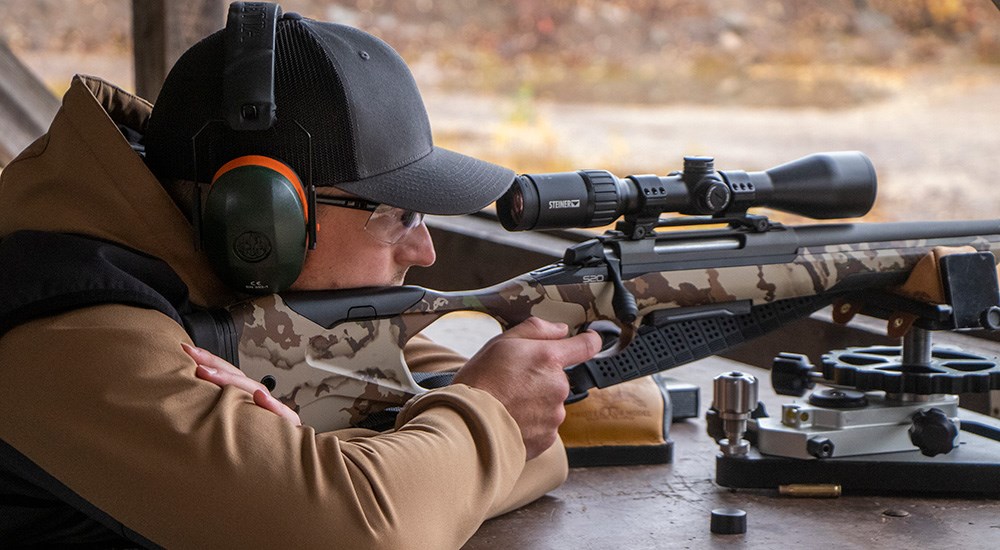
Now, when I say I was equipped with the Sako S20 Precision, I mean that I was given a rifle with a pre-zeroed (at 100 yards) Steiner Predator 8 2-16x42mm scope on it. Like my dad, I’d be going into the hunting test with a gun I’d never shot before, and lo and behold, I was up first out of our group of more than 25 writers, salesmen and Sako/Beretta staff from all over the world. Fortunately, Finland has made the hunting test quite a bit easier in the 32 years since my dad took it. Gone is the moving target and the requirement to shoot offhand. We were allowed to shoot a stationary target at 80 meters from a rest, which, quite frankly, is almost insulting. The most difficult part, and it was not at all difficult, was the time limit of 90 seconds to put four shots in a 12-inch circle located in the vitals area of a paper moose. With a Sako rifle, I’m reasonably certain a blind person with no arms could do that, and needless to say every shooter passed the test with flying colors; all of my rounds were touching in the center of the circle.
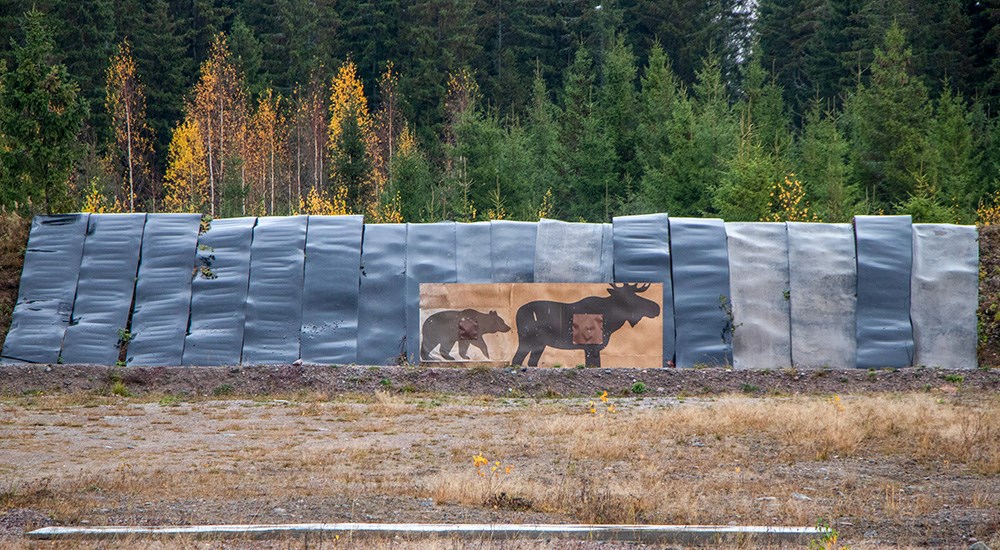
Which brings us to the long-awaited hunt. One of my least favorite things about hunting, and I doubt I’m alone in this hatred, is the need to wake up at truly uncivilized hours to pursue game. Did you know there’s a 4 o’clock in the morning? You shouldn’t, because you, like all normal people, should be sleeping at that time, wrapped up in dreams of, say, Sanna Marin. But no! Mr. North American Game Animal insists you wake up at 4 a.m. if you want to have any hope of harvesting him. Not so in Finland, or most of Europe, for that matter. No, we left our hotel in Helsinki at 7:30 a.m. for about an hour’s bus drive to the absolutely Sanna-Marin-esque-gorgeous Finnish countryside. A mix of birch and spruce, there’s little old-growth forest left in Southern Finland (Finland being one of the largest timber exporters on the planet), and the woods are largely, though not entirely, neatly planted rows of younger trees, which takes nothing away from the boreal beauty of the land.
Upon arrival at the 5,000-hectare (12,000-acre), unfenced hunting club, we filled our thermoses with coffee and lined up outside in an L-shaped formation—hunters on the long side, drivers and their dogs on the short side. This was another difference between my hunt and my father’s, as the dogs used were not Norwegian elkhounds but rather a mix of smaller spaniels. Sako’s brilliant research and development director, Miikka Tamminen, explained that elkhounds slowly and gingerly push the moose toward the hunters and will actually distract the moose when hunters are present to provide an easier shot. While ideal for moose hunting, this also takes a long time. In today’s world, time is sadly our most scarce resource, so many Finnish hunting clubs have chosen to use the more rambunctious spaniels to drive moose faster toward the hunters. This creates more opportunities, but also potentially more difficult shots, as the moose are unlikely to stop when these barky pups start their work. And yes, everyone was very much aware of the irony of scrapping the moving-moose-target test while switching to dogs that are more likely to create moving-shot opportunities only.
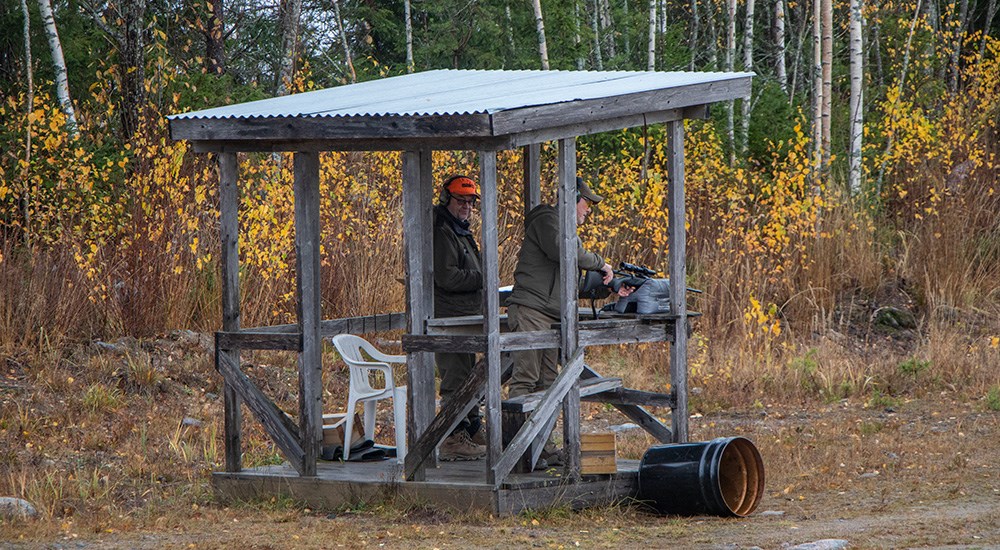
While in the aforementioned L formation, we received our safety brief and a list of animals we could and could not shoot. The list was extensive: any moose, but in the event a cow and a calf showed up, you had to shoot the calf first as it would otherwise starve to death without its mother. You could shoot the cow second. Lone cows and bulls were all fair game, without regard for antler size. The same rules applied to the non-native, but well-established whitetail deer, while similarly non-native fallow and roe deer were bucks only. We could also shoot foxes, but were warned that in no circumstance could we shoot people picking mushrooms or hiking. Apparently, while all the land upon which we would hunt was privately owned, Finnish law allows for certain recreational activities on private property. The hunting club had about a dozen people stationed on nearby roads and trailheads to warn non-hunters making use of the property that hunters were present as an added safety measure. We were also given radios with earpieces so we could hear instructions about when the hunt would start and when it would end, which is when we were to load and unload our rifles, respectively. Hunters were to radio the hunt master should we shoot anything or if we saw game moving by too quickly for a shot.
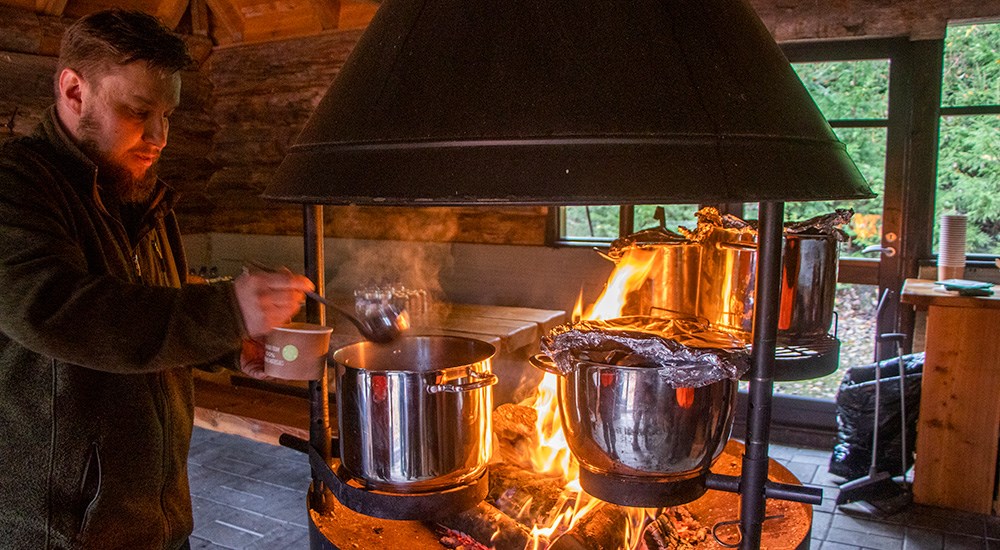
To determine who would sit in each stand, we drew lots in another traditional European way—by picking a small (smaller than a shot glass) metal cup with about a thimble-full of Jägermeister inside. Once all the cups were in hands, a mighty toast to the hunt was made and the tiny amount of “hunt master” alcohol was downed to reveal a number at the bottom of the cup, which was your stand number for the first drive. I know what you’re thinking—never mix alcohol and firearms, and you’re right. Fortunately, the amount of alcohol in the glass would not impair an infant, and in Finland, the rules are different. Also, no one looked askance if you tossed the Jägermeister over your shoulder. Anyway, I drew what I thought was lucky number seven.
Driving through the woods to the hunting area, we could see the placement of each hunter along the way, with the stands set about 100 to 150 yards apart. Each hunter was told what the safe shooting directions were, and a radio signal started the hunt once we were all safely in the stands, which we were not to leave until receiving the “hunt is over” signal. This process was repeated three times: twice before lunch and once after.
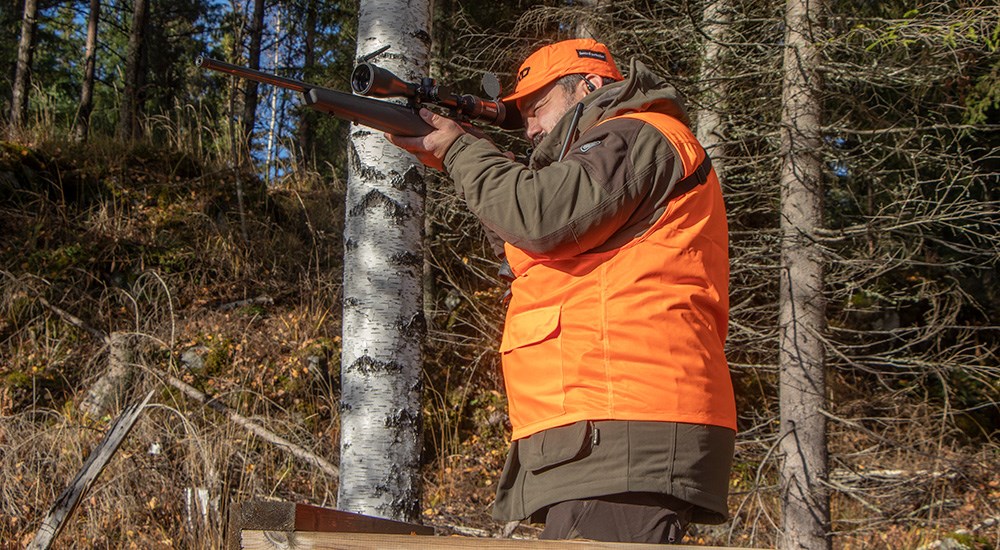
During the second drive, I had my chance. A lone cow moose came rambling from left to right in the woods below my hillside stand at about 150 yards. While I had a clear shot, I also had to ensure it was alone, lest I deprive a calf of its mother. When it became clear that it was, in fact, alone, however, it immediately turned and faced me head-on, moving at a pace shy of a gallop, but too fast to take an ethical shot given the angle. I kept the illuminated crosshair on the moose, hoping it would turn ever-so-slightly one way or another. As it disappeared behind a thick bramble, I saw that I’d have a perfect broadside shot when it came out on the other side.
Within a millisecond of that thought, a shot rang out, followed very closely by a distinctive slap indicating a solid hit on the animal by the Sako Blade bullet we were all using. The hunter in the next stand, John Geiger of Safari Club International, had, completely unbeknownst to him, “stolen” my moose. Of course, this is how driven hunts work. He had the shot and very rightly took it. After the drive ended, I went downhill from my stand to see if I could help find his (my) moose. Sure enough, I did—about 30 yards from my stand down at the bottom of the hill beneath the logging road we used to navigate through the woods.
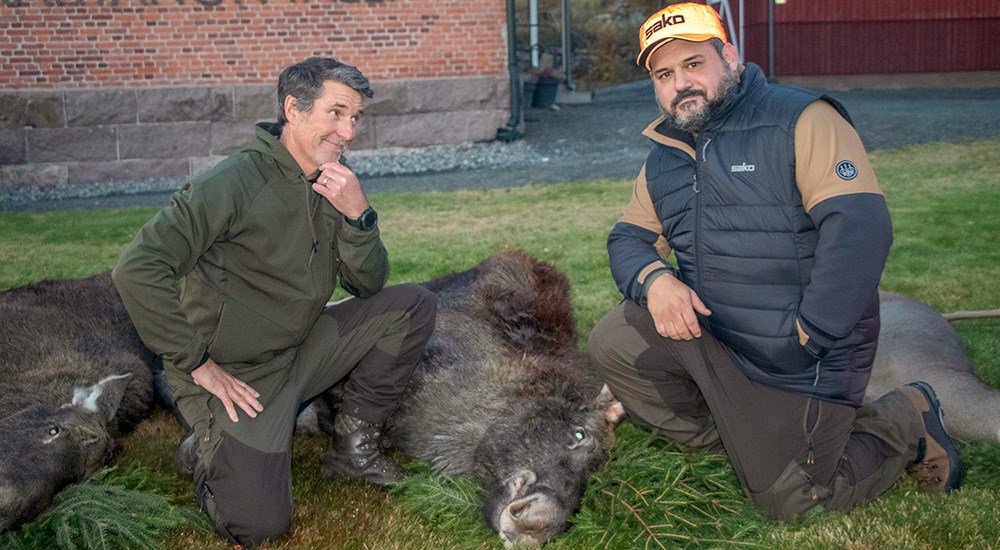 The author, far right, poses with “his” moose and the hunter who actually shot it.
The author, far right, poses with “his” moose and the hunter who actually shot it.
After some good ribbing, it was time for lunch and more storytelling/excuses. That was to be the only animal I encountered all day, and also the last moose we were allowed to take, as the hunt master declared moose closed for the day thanks to the group’s success in thinning the large moose herd in the area.
So, like my father before me and, for that matter, his father before him since he never hunted anything, much less moose in Finland (although Grampy did hunt Japanese cities in World War II), I also came home empty-handed from a once-in-a-lifetime experience in a wonderful country. But killing a moose turns out to be the least important part of this kind of hunt. Over the three days spent in Finland with Sako and Beretta employees and writers from Canada, Australia, New Zealand and, of course, the USA, I made lasting friendships and enjoyed tales of joy and woe. The woe mainly being reserved for the horrible governments in all the Anglosphere nations represented, with the joy coming from our collective experiences hunting and shooting.

As is Finnish tradition, following the hunt the game taken that day is arrayed in a “parade” while the hunters and dog handlers give thanks for a successful outing.
That evening, over a dinner of moose and whitetail stew and mouthwatering smoked whitetail, we toasted Sako, our hunt master, the game drivers and each other, celebrating a successful hunt and a rousing triumph of a product showcase for the Sako S20. Despite my personal lack of success, it was a perfect trip, and a reminder of all the good hunting offers, even for those who came to it later in life.
Well, it was almost perfect, because Sanna Marin still doesn’t return my emails.



































